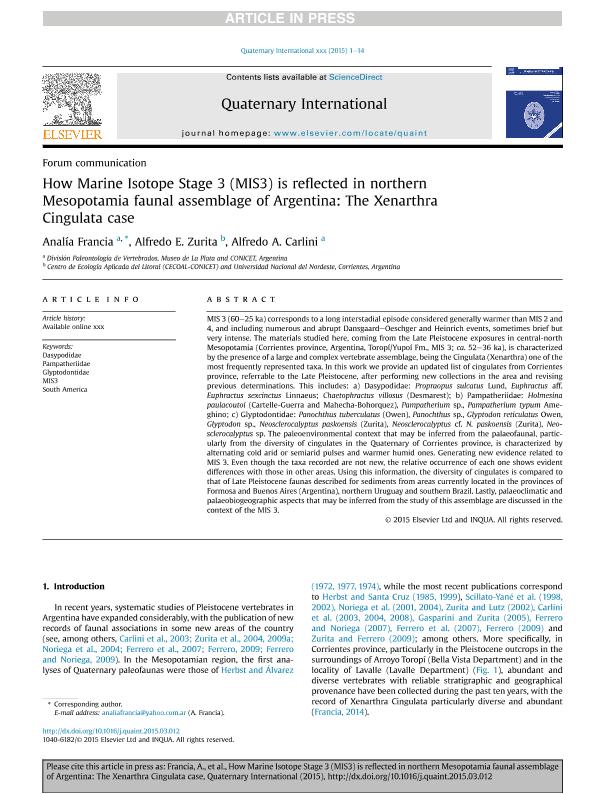Mostrar el registro sencillo del ítem
dc.contributor.author
Francia, Analia

dc.contributor.author
Zurita, Alfredo Eduardo

dc.contributor.author
Carlini, Alfredo Armando

dc.date.available
2018-06-26T18:40:44Z
dc.date.issued
2015-04
dc.identifier.citation
Francia, Analia; Zurita, Alfredo Eduardo; Carlini, Alfredo Armando; How Marine Isotope Stage 3 (MIS3) is reflected in northern Mesopotamia faunal assemblage of Argentina: The Xenarthra Cingulata case; Pergamon-Elsevier Science Ltd; Quaternary International; 377; 4-2015; 126-139
dc.identifier.issn
1040-6182
dc.identifier.uri
http://hdl.handle.net/11336/50125
dc.description.abstract
MIS 3 (60-25 ka) corresponds to a long interstadial episode considered generally warmer than MIS 2 and 4, and including numerous and abrupt Dansgaard-Oeschger and Heinrich events, sometimes brief but very intense. The materials studied here, coming from the Late Pleistocene exposures in central-north Mesopotamia (Corrientes province, Argentina, Toropí/Yupoí Fm., MIS 3; ca. 52-36 ka), is characterized by the presence of a large and complex vertebrate assemblage, being the Cingulata (Xenarthra) one of the most frequently represented taxa. In this work we provide an updated list of cingulates from Corrientes province, referrable to the Late Pleistocene, after performing new collections in the area and revising previous determinations. This includes: a) Dasypodidae: Propraopus sulcatus Lund, Euphractus aff. Euphractus sexcinctus Linnaeus; Chaetophractus villosus (Desmarest); b) Pampatheriidae: Holmesina paulacoutoi (Cartelle-Guerra and Mahecha-Bohorquez), Pampatherium sp., Pampatherium typum Ameghino; c) Glyptodontidae: Panochthus tuberculatus (Owen), Panochthus sp., Glyptodon reticulatus Owen, Glyptodon sp., Neosclerocalyptus paskoensis (Zurita), Neosclerocalyptus cf. N. paskoensis (Zurita), Neosclerocalyptus sp. The paleoenvironmental context that may be inferred from the palaeofaunal, particularly from the diversity of cingulates in the Quaternary of Corrientes province, is characterized by alternating cold arid or semiarid pulses and warmer humid ones. Generating new evidence related to MIS 3. Even though the taxa recorded are not new, the relative occurrence of each one shows evident differences with those in other areas. Using this information, the diversity of cingulates is compared to that of Late Pleistocene faunas described for sediments from areas currently located in the provinces of Formosa and Buenos Aires (Argentina), northern Uruguay and southern Brazil. Lastly, palaeoclimatic and palaeobiogeographic aspects that may be inferred from the study of this assemblage are discussed in the context of the MIS 3.
dc.format
application/pdf
dc.language.iso
eng
dc.publisher
Pergamon-Elsevier Science Ltd

dc.rights
info:eu-repo/semantics/openAccess
dc.rights.uri
https://creativecommons.org/licenses/by-nc-nd/2.5/ar/
dc.subject
Dasypodidae
dc.subject
Glyptodontidae
dc.subject
Mis3
dc.subject
Pampatheriidae
dc.subject
South America
dc.subject.classification
Paleontología

dc.subject.classification
Ciencias de la Tierra y relacionadas con el Medio Ambiente

dc.subject.classification
CIENCIAS NATURALES Y EXACTAS

dc.title
How Marine Isotope Stage 3 (MIS3) is reflected in northern Mesopotamia faunal assemblage of Argentina: The Xenarthra Cingulata case
dc.type
info:eu-repo/semantics/article
dc.type
info:ar-repo/semantics/artículo
dc.type
info:eu-repo/semantics/publishedVersion
dc.date.updated
2018-06-26T13:38:39Z
dc.journal.volume
377
dc.journal.pagination
126-139
dc.journal.pais
Estados Unidos

dc.journal.ciudad
Amsterdam
dc.description.fil
Fil: Francia, Analia. Universidad Nacional de La Plata. Facultad de Ciencias Naturales y Museo. División Paleontología Vertebrados; Argentina. Consejo Nacional de Investigaciones Científicas y Técnicas; Argentina
dc.description.fil
Fil: Zurita, Alfredo Eduardo. Consejo Nacional de Investigaciones Científicas y Técnicas. Centro Científico Tecnológico Conicet - Nordeste. Centro de Ecología Aplicada del Litoral. Universidad Nacional del Nordeste. Centro de Ecología Aplicada del Litoral; Argentina
dc.description.fil
Fil: Carlini, Alfredo Armando. Universidad Nacional de La Plata. Facultad de Ciencias Naturales y Museo. División Paleontología Vertebrados; Argentina. Consejo Nacional de Investigaciones Científicas y Técnicas; Argentina
dc.journal.title
Quaternary International

dc.relation.alternativeid
info:eu-repo/semantics/altIdentifier/doi/http://dx.doi.org/10.1016/j.quaint.2015.03.012
dc.relation.alternativeid
info:eu-repo/semantics/altIdentifier/url/https://www.sciencedirect.com/science/article/pii/S1040618215001962
Archivos asociados
